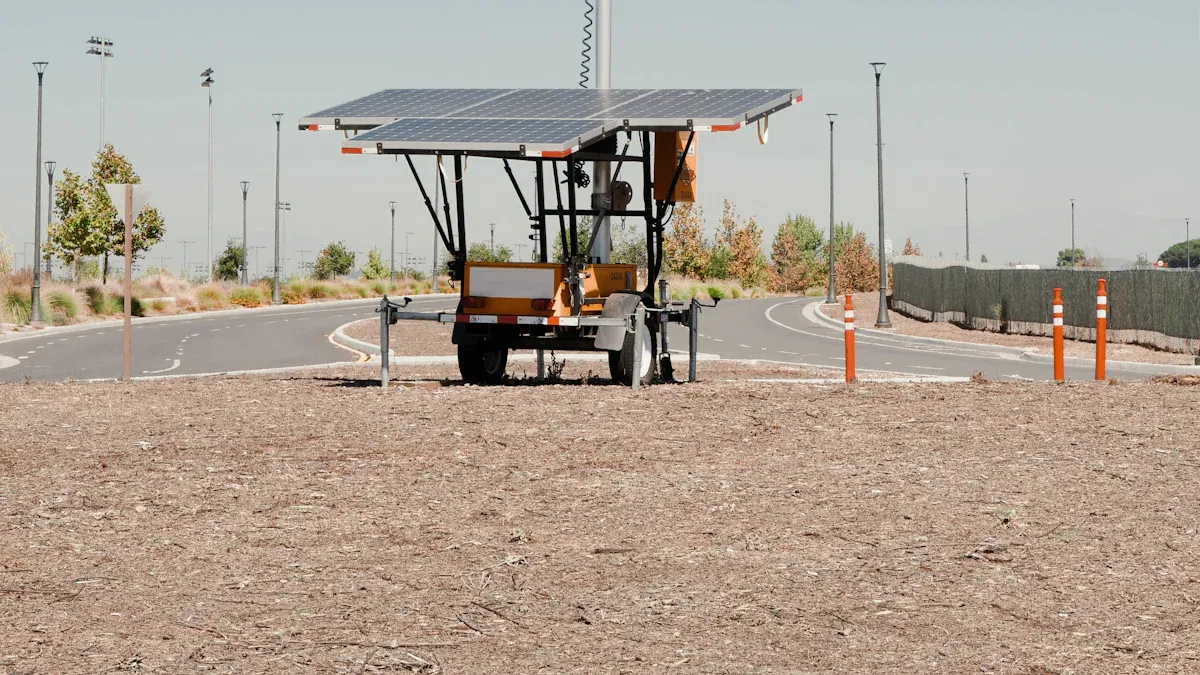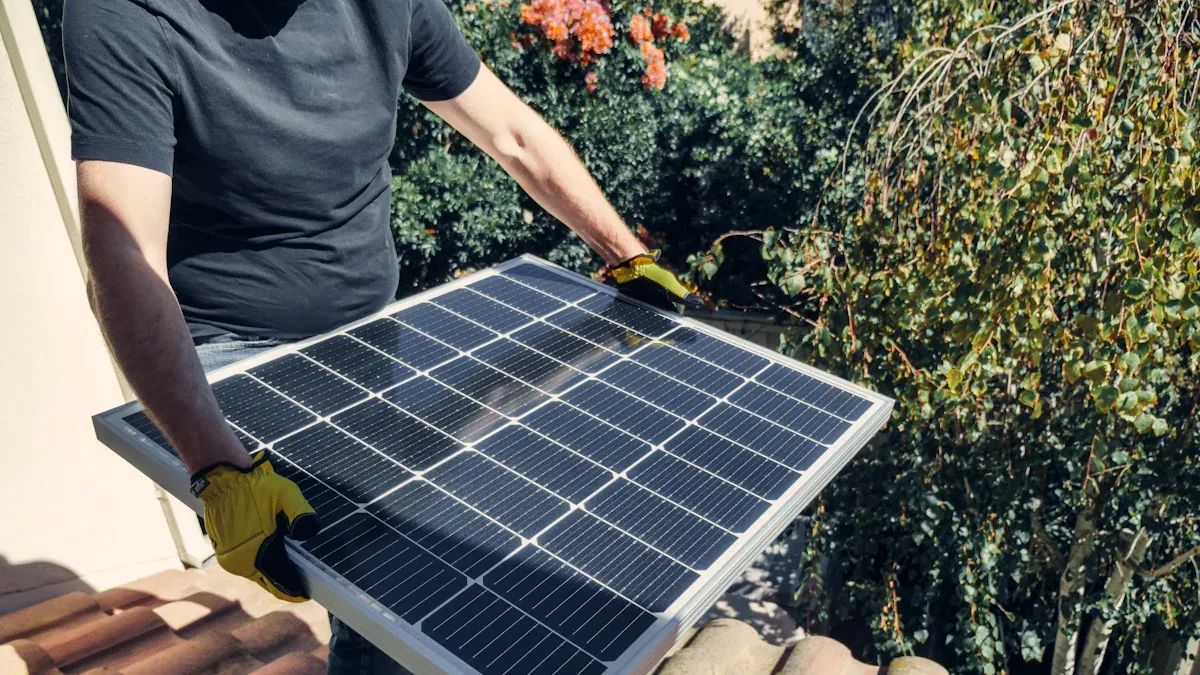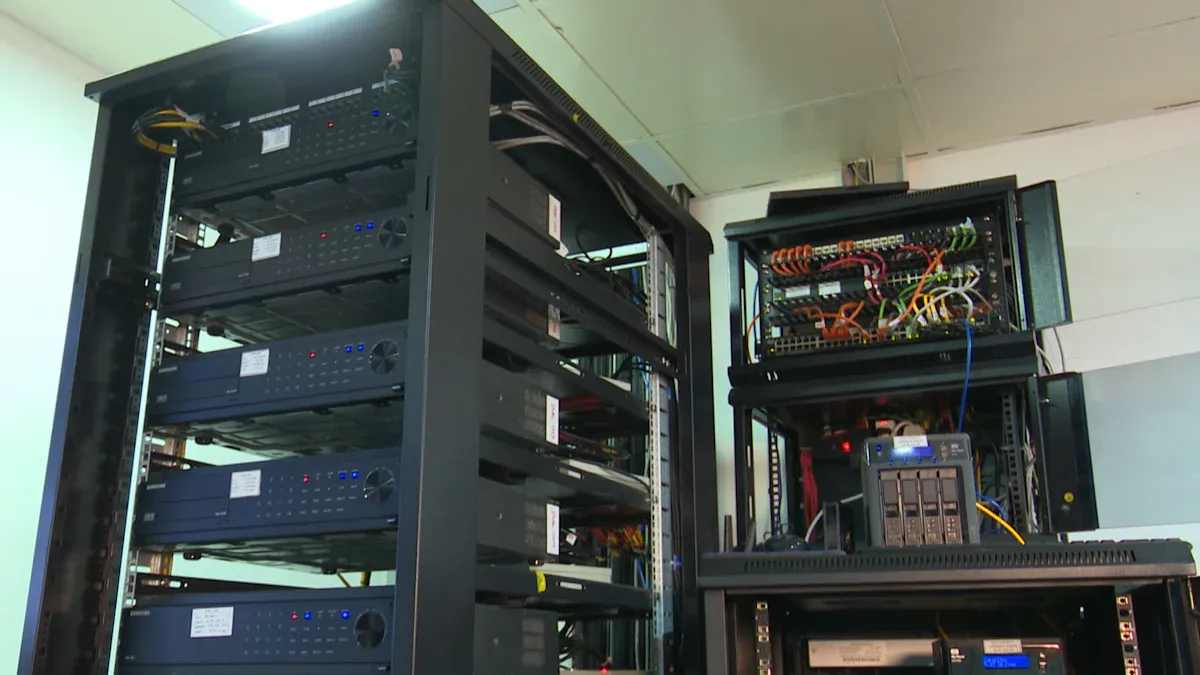Secondary Role of Solar Modules in Telecom Cabinets as Emergency Power Supply During Grid Outages

Telecom networks depend on uninterrupted power to maintain communication during grid outages. Solar Module systems, when combined with battery storage and advanced inverters, supply emergency backup power to telecom cabinets. Many operators now choose solar-powered solutions instead of diesel generators for greater resilience and sustainability.
Reliable backup power protects critical infrastructure and keeps communities connected during emergencies.
Key Takeaways
Solar modules combined with batteries and inverters provide reliable emergency power to telecom cabinets during grid outages.
Battery storage, especially lithium iron phosphate types, offers long life and safety while supporting continuous telecom operations.
Advanced inverters and automatic switching ensure smooth power transitions and stable electricity for sensitive telecom equipment.
Solar-powered systems reduce diesel generator use, lower costs, cut emissions, and improve network reliability in remote and disaster areas.
Proper site assessment, system sizing, and staff training are essential for effective solar backup system performance and maintenance.
Solar Module Integration

Telecom cabinets rely on a well-coordinated system to ensure emergency power during grid outages. The integration of solar modules, battery storage, and advanced inverters forms the backbone of this reliable backup solution. Each component plays a unique role in maintaining continuous operation for critical communication infrastructure.
Battery Storage Systems
Battery storage acts as the energy reservoir for telecom cabinets. Most systems use 48V lithium iron phosphate (LiFePO4) batteries because they offer long cycle life, high reliability, and safety. These batteries can operate in harsh outdoor environments and fit into compact, rack-mountable designs. Their modular nature allows for easy scaling, so operators can adjust capacity based on site needs.
IP54-rated outdoor enclosures protect batteries from dust and water, ensuring durability.
Hybrid power systems combine grid, generator, and solar inputs to maximize reliability and reduce costs.
Lithium iron phosphate batteries provide over 4000 charge cycles and include smart management systems for real-time monitoring.
Field Supervision Units (FSUs) support protocols like Modbus and SNMP, allowing integration with remote monitoring platforms.
Proper site preparation includes grounding, ventilation, and secure anchoring to resist environmental challenges.
Battery capacity directly determines how long telecom equipment can run during an outage. Operators use the formula:Capacity (Ah) = Load (W) × Backup Time (h) ÷ Battery Voltage (V)
Increasing battery capacity extends backup time, but factors like temperature and depth of discharge also affect performance. Accurate calculations and regular maintenance ensure reliable emergency power.
Lithium iron phosphate batteries are environmentally friendly and maintenance-free, making them ideal for sustainable telecom backup systems.
Inverter Technology
Inverters convert the DC power from solar modules and batteries into AC power for telecom equipment. Pure sine wave inverters are preferred because they deliver clean, stable electricity that sensitive devices require. Hybrid inverters go a step further by integrating battery management, real-time monitoring, and transfer switches into a single unit.
Hybrid inverters manage power flows between solar modules, batteries, and backup generators.
Grid-forming inverters establish stable AC voltage and frequency, allowing seamless synchronization with other power sources.
Advanced features like multi-MPPT tracking and AI-based energy management boost efficiency above 98%.
Central microgrid controllers optimize power dispatch, prioritizing renewable energy and stabilizing loads.
These technologies ensure that telecom cabinets receive uninterrupted power, even during surges or harsh environmental conditions. Hybrid and central inverters suit larger or more complex telecom sites, while string and microinverters work well for smaller setups.
Automatic Switching
Automatic switching technology guarantees that telecom cabinets transition smoothly between grid and backup power. Systems like Automatic Transfer Switches (ATS) and Static Transfer Switches (STS) monitor the main power source and instantly activate solar or battery backup when needed.
ATS continuously checks for grid outages or fluctuations.
When a problem occurs, it initiates the transfer process.
The backup source, such as a solar inverter or generator, activates.
The ATS automatically shifts the load from the grid to the backup source.
When grid power returns, the ATS switches the load back seamlessly.
These switches use fast-acting relays and circuit breakers, achieving transfer times as low as 10 milliseconds. This rapid response prevents service interruptions and protects sensitive telecom equipment. Redundant components, advanced thermal management, and regular maintenance further enhance reliability.
Automatic switching reduces human error and operational delays.
Closed Transition ATS ensures no interruption by briefly paralleling main and backup power.
Systems support integration with multiple power sources, including solar modules, batteries, and generators.
Large-scale deployments in Europe have shown that automatic switching and robust backup systems can reduce battery failures by 98% and maintain over 95% efficiency, even under heavy loads.
The combination of solar modules, advanced batteries, inverters, and automatic switching creates a resilient emergency power system for telecom cabinets. This integration supports continuous communication, even during extended grid outages.
Benefits for Telecom Cabinets

Network Continuity
Telecom cabinets must deliver reliable service, even when the main power grid fails. Solar-powered systems help maintain network operations during outages and unstable grid conditions. Many operators install solar modules at off-grid sites to ensure continuous power. These systems often include surge protection and power quality measures, which enhance the reliability of outdoor telecom enclosures.
Solar integration supports network uptime during power interruptions.
Surge protection and power quality features improve operational efficiency.
Cabinets with solar backup maintain service in challenging environments.
A properly sized solar system further improves network continuity. The table below compares how different solar panel capacities respond to common scenarios:
Scenario | 100W Panel Response | 200W Panel Response |
|---|---|---|
Cloudy weather | Risk of undercharging, battery underperformance | Maintains adequate charging, stable power supply |
Load spike | Possible voltage drop, service interruptions | Handles surge smoothly, protects equipment and uptime |
Equipment upgrade | May require panel replacement | Supports new load, enhances reliability |
A 200W solar panel provides a power buffer, reducing deep battery discharges and extending battery life. Intelligent monitoring and proper sizing help mitigate power fluctuations and environmental impacts, ensuring telecom cabinets stay online.
Reliable network continuity keeps communities connected, especially during emergencies.
Reduced Diesel Use
Traditional telecom backup systems rely heavily on diesel generators. These generators consume large amounts of fuel and require frequent maintenance. By integrating solar modules with battery storage, telecom operators have reduced diesel generator usage by over 90%. This shift leads to significant fuel cost savings, with some systems saving up to $31,900 annually. In South Africa, solar photovoltaic systems for telecom towers have cut operational costs by as much as 49% compared to diesel-only setups.
Solar-powered telecom cabinets reduce diesel generator runtime by over 80%.
Hybrid solar-diesel systems lower operational costs by up to 40%.
Decentralized solar power supports grid stability and microgrids, ensuring continuous service during outages.
Solar systems reduce emissions by over 55%, supporting sustainability goals.
Diesel generators in telecom towers can consume more than 7,000 liters of fuel each year, producing millions of tons of CO2 emissions. Solar backup systems replace much of this fossil fuel use with clean, renewable energy. The International Renewable Energy Agency estimates that solar adoption in telecom could lower industry emissions by 60% by 2030. Each telecom tower that switches to solar contributes to a healthier environment and supports climate change mitigation.
Disaster Recovery
Natural disasters often damage power infrastructure, making reliable backup power essential for telecom networks. Solar-powered telecom cabinets provide steady, off-grid electricity to base stations and cell towers. Their weatherproof design allows them to operate in harsh conditions, ensuring continuous communication when the grid fails.
Solar telecom cabinets deliver power in remote and disaster-affected areas.
Lithium-ion batteries and smart energy management keep equipment running during cloudy days and at night.
Modular designs allow easy upgrades for expanding networks and new technologies.
These cabinets operate quietly and require less maintenance than diesel generators.
During disasters, they power emergency communication tools and withstand harsh weather.
Solar power offers immediate, fuel-free energy in disaster zones. It enables charging of communication devices without relying on fuel deliveries or transportation. Decentralized solar energy reduces vulnerability to centralized power failures, enhancing resilience during prolonged outages. Solar systems also support critical facilities like hospitals and shelters, maintaining operations during emergencies.
After Hurricane Maria, solar-powered microgrids supplied electricity to remote areas with damaged infrastructure, helping recovery efforts. Portable solar kits and hybrid backup systems have kept communication lines open in hurricane and flood zones worldwide. Investing in solar-powered disaster recovery systems builds long-term resilience and enables faster response and recovery.
Solar-powered telecom cabinets play a crucial role in disaster recovery by maintaining communication lines and supporting emergency response teams.
Implementation Strategies
Site Assessment
Telecom operators begin by conducting a thorough site assessment before installing solar modules. This process ensures the system will perform reliably and efficiently. Key steps include:
Complete a feasibility study to determine if solar integration is practical.
Measure sunlight availability, shading, and local weather patterns.
Analyze environmental conditions such as temperature and dust accumulation.
Check the structural suitability and available space for solar panels.
Assess the energy requirements of the telecom equipment.
Use solar mapping software to evaluate sunlight exposure.
Monitor environmental factors to optimize system design.
Environmental factors play a major role in site assessment. Sunlight hours, shading, and panel orientation directly affect energy output. Operators often select south-facing panels in the Northern Hemisphere to maximize sunlight. Regular cleaning and maintenance help prevent dust and pollution from reducing efficiency. Corrosion-resistant mounting materials and weatherproof installations protect equipment from harsh conditions.
Proper site assessment ensures reliable operation and maximizes the return on investment for solar-powered telecom cabinets.
System Sizing
Accurate system sizing is essential for reliable emergency power. Operators calculate the total daily power consumption by adding up the needs of all equipment in the cabinet. They then apply a safety margin, often doubling the calculated demand, to account for unexpected usage or future upgrades. Two main strategies guide sizing:
Consumption Strategy:
PV Size [W] = Margin × (Daily Consumption [Wh]) / (Light Exposure [h])Battery Strategy:
PV Size [W] = Margin × (Battery Capacity [Wh]) / (Desired Charge Time [h])
Oversizing the system by at least 20% helps account for inefficiencies and environmental changes. Proper sizing prevents equipment overload, reduces downtime, and extends battery life. Hybrid systems and redundancy in battery modules further improve reliability.
Staff Training
Well-trained staff ensure the safe and effective operation of solar emergency power systems. Training programs cover electrical safety, technical skills, and system maintenance. The table below highlights key programs:
Training Program Name | Key Focus Areas | Relevance to Telecom Staff Managing Solar Emergency Power Systems |
|---|---|---|
NFPA 70E Electrical Safety Training | Electrical safety knowledge, best work practices, real-world application | Essential for safe handling of electrical components in solar emergency power systems |
GWO Accredited Courses | Safety and technical training standards, electrical/fire safety, working at height, manual handling, first aid, risk assessment | Provides standardized, industry-recognized training expanding into solar sector |
Bespoke Training Programs | Customized training tailored to client-specific operational needs | Ensures training is directly applicable to telecom staff’s unique solar system tasks |
STL USA Training Programs | Integration of NFPA 70E and GWO standards, cutting-edge, compliant training | Leading provider ensuring technicians meet latest industry requirements |
Staff who receive proper training can respond quickly to emergencies, maintain equipment safely, and reduce the risk of system failures. This preparation protects both personnel and infrastructure, supporting continuous telecom operations.
Challenges and Opportunities
Technical Limits
Solar-powered telecom cabinets face several technical challenges that affect their long-term performance. Regular maintenance and auditing remain essential for reliable operation. Operators must anchor cabinets firmly to prevent tampering and use safe cable management to avoid accidental disconnections. Environmental controls, such as climate regulation and dust protection, help protect sensitive equipment from harsh conditions. Security measures, including robust locks and regular credential updates, prevent unauthorized access.
Operators conduct regular physical integrity checks to detect tampering or damage.
Monitoring access logs helps identify abnormal entries.
Surge protection devices inside cabinets guard against power surges and reduce downtime.
Weather-resistant designs and EMI shielding protect equipment year-round.
Well-maintained cabinets extend equipment lifespan, reduce repair costs, and minimize downtime. These measures also help operators avoid penalties for service interruptions and maintain customer trust.
Funding Needs
Investment in solar-powered backup systems can present financial challenges, especially for large-scale deployments. Operators must consider the upfront costs of solar modules, batteries, inverters, and advanced monitoring systems. However, well-maintained cabinets with environmental protection features can reduce long-term expenses by preventing water intrusion, overheating, and electrical damage. Insurance premium savings and lower maintenance costs can offset initial investments over time.
Cost Factor | Short-Term Impact | Long-Term Benefit |
|---|---|---|
Equipment Purchase | High | Lower replacement frequency |
Installation | Moderate | Reduced repair and downtime |
Maintenance | Ongoing | Extended equipment lifespan |
Security Upgrades | Moderate | Fewer theft and vandalism losses |
Operators who plan for both immediate and future costs can achieve better financial outcomes and more reliable service.
Innovation Trends
Recent innovations have improved the performance and reliability of solar-powered telecom cabinets. Smart technology, such as IoT-enabled monitoring and remote diagnostics, allows operators to track system performance and detect faults in real time. Modular and scalable cabinet designs support rapid upgrades, which is important for expanding 5G networks. Weather-resistant materials and compact designs enable deployment in diverse environments.
Advanced MPPT controllers achieve conversion efficiencies above 97%.
Remote monitoring systems provide real-time data and fault alerts.
Hybrid cabinet designs combine solar power with edge computing for high-capacity networks.
Regulatory changes encourage faster deployment and infrastructure sharing.
Telecom operators collaborate with technology providers to integrate cellular connectivity and IoT solutions. These partnerships enable intelligent energy distribution and reliable emergency power, even in remote locations. As innovation continues, solar-powered telecom cabinets will become more efficient, secure, and adaptable to future network demands.
Real-World Cases
Remote Deployments
Telecom operators often face challenges when deploying infrastructure in remote or off-grid locations. Solar-powered telecom cabinets have become a practical solution in these areas. Operators in Africa and the Middle East use solar modules to maintain reliable service where grid power remains unstable or unavailable. For example, telecom companies in Kenya and South Sudan have installed solar-powered towers in rural regions. These towers operate independently from the grid and provide continuous connectivity for local communities.
Solar modules paired with battery storage systems allow telecom cabinets to function during extended outages. Modular designs help operators scale their systems based on demand. In South Sudan, MTN uses solar energy to reduce fuel costs and improve network reliability. European operators deploy ESTEL’s modular solar plants in isolated areas, ensuring uninterrupted service and reducing carbon emissions. These real-world deployments show that solar-powered solutions support both operational reliability and environmental sustainability.
Solar-powered telecom cabinets keep remote communities connected, even during natural disasters or prolonged grid failures.
Measured Impacts
Operators have reported significant benefits after integrating solar modules into telecom cabinets. The following list highlights some of the most notable impacts:
Telecom operators in Kenya achieved a 40% reduction in energy expenses by using solar-powered towers.
MTN South Sudan saw a 30% decrease in fuel costs after switching to solar energy solutions.
Solar PV hybrid systems currently reduce CO2 emissions by about 55%. As 5G networks expand, this reduction could reach 58%.
European telecom operators using ESTEL’s modular solar plants lowered their carbon footprint by around 30%.
du’s Solar on Tower Project cut carbon emissions by 3,750 tons each year through solar panel installations.
ESTEL’s hybrid solar systems deliver up to 75% energy savings by improving cooling efficiency and reducing reliance on fossil fuels.
Solar-powered systems increase operational reliability, especially in remote areas, by minimizing downtime and ensuring uninterrupted connectivity.
Modular and hybrid solar solutions allow operators to scale energy systems flexibly, which strengthens network resilience and sustainability.
These measured impacts demonstrate that solar module integration in telecom cabinets leads to lower operational costs, reduced emissions, and improved service reliability. Operators continue to adopt solar solutions to meet sustainability goals and support resilient communication networks.
Telecom operators gain reliable emergency power by integrating Solar Module systems into cabinets. These solutions deliver network continuity, reduce diesel use, and support disaster recovery. Technical advancements improve efficiency and resilience. Industry leaders see solar energy as a strategic investment for future-proofing networks.
Policy support and innovation will drive wider adoption.
Stakeholders should evaluate solar integration to strengthen emergency backup.
FAQ
What happens if there is not enough sunlight for the solar modules?
Solar modules still generate some power on cloudy days. Battery storage provides backup energy when sunlight is low. Operators often oversize systems to ensure reliable power during extended periods of poor weather.
How long can telecom cabinets run on solar backup during an outage?
Backup duration depends on battery capacity and equipment load. Most systems provide several hours to a full day of emergency power. Operators calculate battery size based on expected outage length and power needs.
Do solar-powered telecom cabinets need regular maintenance?
Yes. Operators clean solar panels, check battery health, and inspect electrical connections. Routine maintenance ensures optimal performance and extends equipment lifespan. Remote monitoring systems help detect issues early.
Can solar modules power telecom cabinets in remote locations?
Yes. Solar modules work well in off-grid or remote areas. They provide reliable power where grid access is limited or unavailable. Modular designs allow easy scaling for different site requirements.
Are solar-powered systems more expensive than diesel generators?
Initial costs for solar systems are higher. Over time, operators save money on fuel and maintenance. Solar-powered systems reduce operational expenses and support sustainability goals.
See Also
Solar Energy Storage Solutions For Telecom Cabinet Power
Telecom Cabinet Battery And Solar Inverter Grid Integration
Strategies To Guarantee Stable Power For Telecom Cabinets
Methods For Calculating Power And Batteries In Telecom Cabinets
CALL US DIRECTLY
86-13752765943
3A-8, SHUIWAN 1979 SQUARE (PHASE II), NO.111, TAIZI ROAD,SHUIWAN COMMUNITY, ZHAOSHANG STREET, NANSHAN DISTRICT, SHENZHEN, GUANGDONG, CHINA


